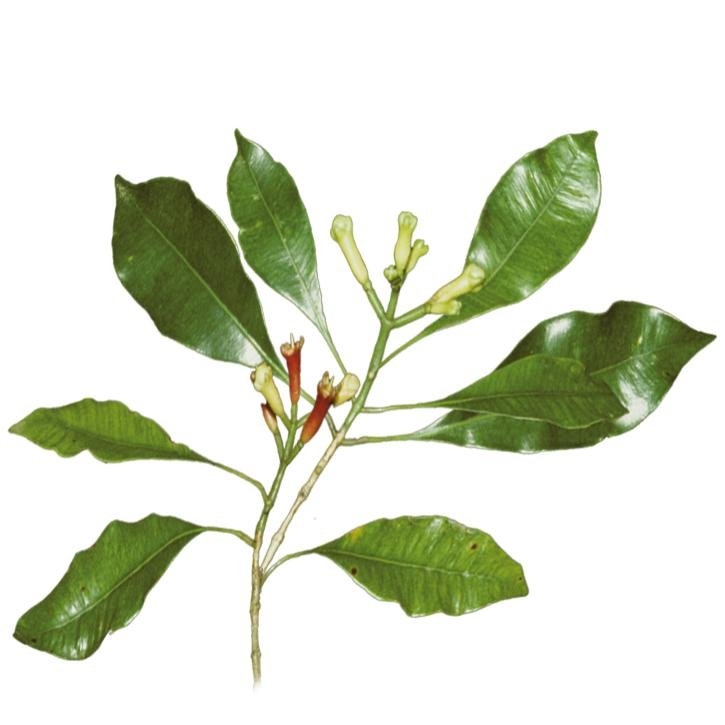Description
The clove tree is a tree of the Myrtaceae family native to the Molucca Islands, it is traditionally cultivated in Tanzania, Madagascar and Indonesia.
It is an evergreen tree 10 to 20 meters high. The leaves are lanceolate and the inflorescences are racemose (thyrsus). The flower buds are, at first, pale in color, changing to green and then to bright red, ideal time for harvesting. These buds are formed by a long receptacle containing the ovary and, on the receptacle are inserted sepals (4), petals (4) and numerous stamens. They are usually harvested when they reach 1.5-2 cm in length.
They are called cloves or girofles to the dried buds (flowers that have not yet opened), and are widely used as a condiment either whole or ground but in small quantities because they are very strong. They are also used to make incense in Chinese and Japanese culture, and is one of the ingredients of Jewish incense used in the Temple of Solomon.
Part used
- Dried flower buds.
- Essential oil obtained by steam distillation of dried flower buds.
Active ingredients
- Abundant essential oil (15-20%), composed mainly of eugenol (80-85%). Other constituents are eugenyl acetate and β-caryophyllene.
- C-glucosylchromones: bioflorin and isobiflorin.
- Tannins (10-13%), among which ellagitannin eugeniin stands out. In addition, casuarictin, telimagrandin I and 1,3-di-O-galoyl-4,6(S)-hexahydroxydiiphenyl-β-D-glucopyranose are found.
- Phytosterols: sitosterol, stigmasterol and campestrol.
- Flavonoids: eugenin, kaempferol, rhamnetin and eugenitin.
- Others: triterpenoids (oleanolic acid), sesquiterpenes, methyl salicylate.
Pharmacological action
- Antibacterial: the eugenol of the essential oil has antibacterial activity against Gram-positive and Gram-negative bacteria. The methanolic extract has been shown to be active against different anaerobic pathogens present in the oral cavity, being the flavonoids kempferol and myricetin the main responsible for this action.
- The aqueous extract inhibits the growth of Helicobacter pylori.
- Antifungal: the essential oil inhibits the growth of fungi such as Candida albicans and Candida neoformans.
- Antiviral: Eugenin non-competitively inhibits DNA polymerase of different strains of herpes simplex virus 1 and 2 and also increases the therapeutic efficacy of acyclovir in the treatment of herpes simplex. On the other hand, casuarictin, eugeniin and telimagrandin I interfere in the interaction of glycoproteins gp120 and gp41 involved in HIV virus infection.
- Local anesthetic: eugenol inhibits nerve conduction by activating chloride and calcium channels in ganglion cells.
- Anti-inflammatory: eugenol inhibits prostaglandin synthesis and leukocyte chemotaxis.
- Anti-allergic: it has been found that the aqueous extract inhibits histamine release and stabilizes the mast cell membrane.
- Other: induces apoptosis, intervenes in the regulation of glycemia.
Indications
- Oral care as an antiseptic. Make mouthwashes with the essential oil diluted in water (1-5%) 1 to 3 times a day.
- Mild inflammations of the oropharyngeal mucosa. Rinses or gargles with the essential oil diluted in water (1-5%), several times a day.
- Odontalgia, as a topical anesthetic. Absorbent cotton soaked with a few drops of undiluted essential oil, or at least a minimum of 50% oil, and apply on the painful area for about 20 minutes. If necessary, it can be repeated after 2 hours.
Contraindications
Pregnancy and lactation.
Precautions
It is recommended not to use repeatedly or for a prolonged period of time.
Drug interactions
- In topical use no drug interactions have been described.
- In internal use, due to the antiplatelet action of the essential oil, it could enhance the effect of other antiplatelet or anticoagulant drugs and increase the risk of bleeding.
Side effects
Prolonged use of the essential oil, especially undiluted, may damage the gingival mucosa.
Bibliographic references
-.J. Bruneton. Farmacognosia. Fitoquímica. Plantas Medicinales. Editorial Acribia, 2ª edición.
-.Monografía de la SEFIT (Sociedad Española de Fitoterapia).
-.European Medicines Agency (EMA) - Committee on Herbal Medicinal Products (HMPC). Community herbal monograph on Syzygium aromaticum (L.) Merill et M. Perry, floris aetheroeum. London: EMA. Ref. Doc. EMEA/HMPC/534924/2010. Adopted: 13/9/2011.
-.ESCOP. ESCOP monographs The Scientific Foundation for Herbal Medicinal Products. Online series. Caryophylli haetheroleum (Clove Oil). Exeter: ESCOP; 2014.
-.Batiha GE, Alkazmi LM, Wasef LG, Beshbishy AM, Nadwa EH, Rashwan EK. Syzygium aromaticum L. (Myrtaceae): Traditional Uses, Bioactive Chemical Constituents, Pharmacological and Toxicological Activities. Biomolecules. 2020 Jan 30;10(2).
-.Alqareer A, Alyahya A, Andersson L. The effect of clove and benzocaina versus placebo as topical anesthesics. Journal of Dentistry 2006; 34: 747-750.
-.Cai L, Wu CD. Compounds from Syzygium aromaticum possessing growth inhibitory activity against oral pathogens. Journal of Natural Products 1996; 59 (10): 987-90.
